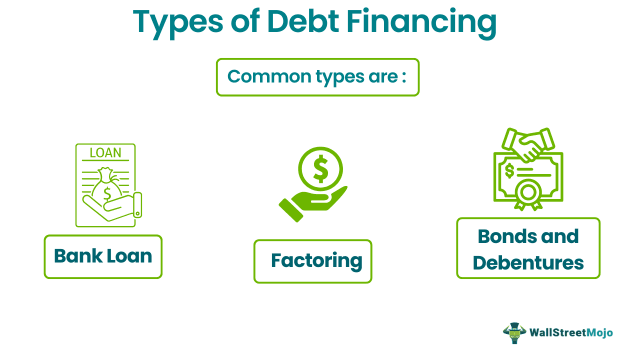Table Of Contents
Debt Financing Definition
Debt financing refers to one of the types of financing in which entities like companies obtain finance by issuing debt instruments or borrowing money from sources like a bank. The funds are used to finance working capital, buy resources, and business expansions.

The entity issuing the debt instruments is the debtor, and the holders of the debt instruments are the creditors. The issuer must repay the creditor in line with the predefined terms and conditions. The contrasting type of this financing is equity financing which involves raising funds by equity issuance.
Key Takeaways
- Debt financing is the type of financing in which companies obtain money for financing various business needs by issuing debt instruments and taking loans from banks or other financial institutions.
- Examples include bond issuance, business credit cards, term loans, peer-to-peer lending services, and invoice factoring.
- Advantages: Easy to access, less costly compared to equity financing, no dilution of ownership, and interest expense reduces tax liability.
- Disadvantages: An increase in debt can disrupt the optimal capital structure, increase debt and debt-equity ratios, and repay obligations.
Debt Financing Explained
Debt financing contributes to the debt portion of a company's capital structure. It can boost a company's performance and growth. There is an optimal amount of debt portion in the capital structure, and management prefers to obtain and use less than the optimal amount to reduce future threats like bankruptcy risk.
One of the important features is that it involves the promise to repay the principal at a future date and periodic interest payments to be carried out in a predefined manner and timeframe. It also discloses that the interest payment attributes to the cost of debt. Usually, the debt instruments tend not to default, and highly rated instruments offer greater assurance. In liquidation, the payment to the creditors or instrument holders is prioritized over shareholders or owners.
Types
There are many types of it in the market. Let's look into a brief description of a few of them:

Bank Loan
A loan occurs when entities like banks and other financial institutions lend money to business entities. The recipient incurs a debt and is liable to pay interest on that debt until it is repaid and to repay the principal amount borrowed. There are many types of loan classifications. For example, it can be a secured loan tied with collateral like mortgages, unsecured like a credit card, a term loan with fixed tenure and repayments, or a revolving loan exhibiting repeated borrowing facilities like credit cards and cash flow loans like invoice financing, etc.
Bonds and Debentures
Bonds and debentures are common debt financing instruments issued by the government and corporate entities to raise capital. Bonds can be secured or unsecured, whereas debentures are unsecured; hence debentures are riskier than bonds. However, both offer interest income to the instrument holders.
Factoring
Factoring is an example of a debt instrument used to create short-term solutions. Factoring involves entities selling the accounts receivables in their books to a third party to obtain short-term liquidity. The third-party pays the equivalent amount minus commission or fees.
Debt Financing Examples
- An Irish-based fintech, Wayflyer, offering affordable funding to other businesses, has secured $300 million via debt financing from J.P. Morgan. It is a part of JP Morgan supporting startups and high-growth companies in technology, disruptive commerce, and life sciences. For startups or SMEs obtaining cash through traditional debt and equity funding is generally difficult. This flexible finance solution is powering the Wayflyer business model. Wayflyer uses this debt line to provide unsecured working capital to other business entities like e-commerce firms. In return, they buy a portion of their future sales.
- Mary owns a small company that manufactures footwear, the company is small but successful, and there is no shortage of demand, supply, and goodwill in the market. Still, Mary wants to expand her business and start manufacturing bags, so she needs more capital and informs her best friend Mandy about her idea and discloses that she is short on money. Mandy likes the idea and wants to help her friend; she tells Mary that she will provide the funds for her business expansion, but it will strictly be professional; Mandy doesn't want to become a partner. Instead, Mandy gives a loan at a subsidized rate to Mary. Hence, Mary financed the capital requirement by obtaining a loan from her friend.
Advantages/Disadvantages
Debt financing advantages:
- There is no dilution of ownership, or the creditor has no say in the debtor's business decision-making.
- Repayment of the loan or crossing the debt instrument's maturity date and completing the payment of interest and principal ends the obligation towards the creditor.
- The interest expense can reduce the tax liability.
- It's easy to access and less costly compared to other forms of financing like equity financing.
Debt financing disadvantages:
- It involves borrowing and repayment of the borrowed amount, usually with interest.
- Increased reliance on this type of financing can affect the optimum capital structure.
- It can increase the debt ratio and debt-equity ratio of a business entity and form unattractive to investors. In addition, this increase will make it difficult for an entity to access more debts.
- Inconsistent or no cash inflows can result in default in debt repayment.

